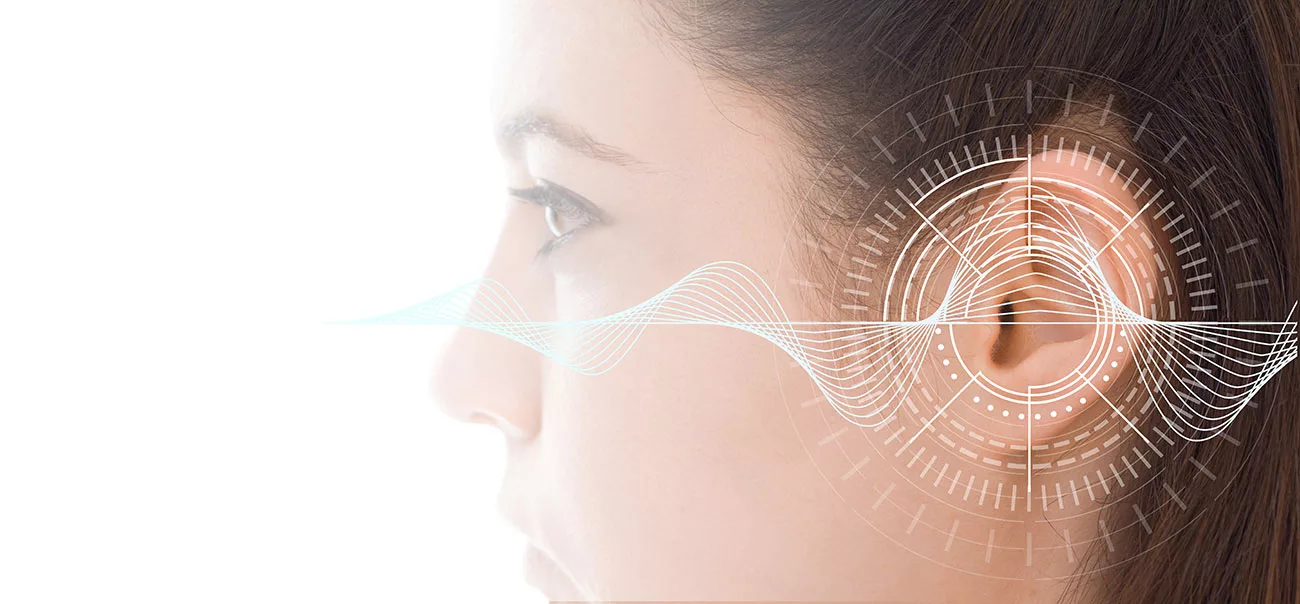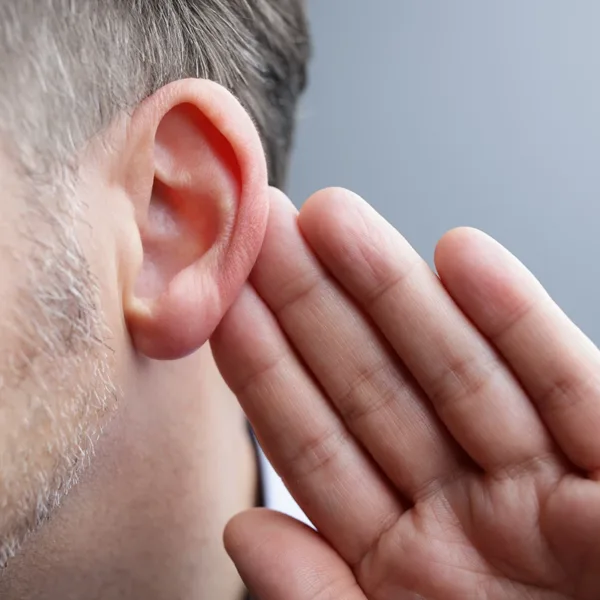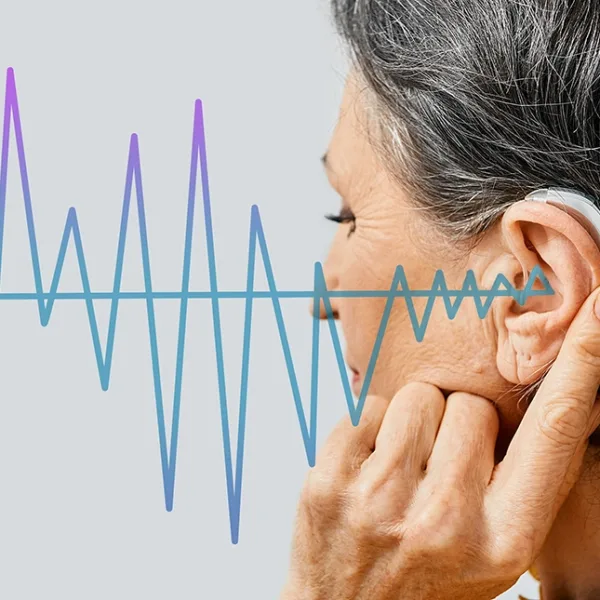
The human ear has an intricate array of mechanisms that work together to receive and process sounds. This enables us to hear a variety of noises such as speech, music, the pitter-patter of tiny feet, rain pelting, a crackling fire, and so much more. Damage or deterioration to any of these vital mechanisms within our ear can cause hearing loss. The two most common types of hearing loss are sensorineural hearing loss and conductive loss. At the most basic level, sensorineural hearing loss stems from damage in the inner ear, whereas conductive hearing loss is caused by a breakdown or blockage in the outer and/or middle ear. In this article, we’ll explore the differences between sensorineural hearing loss vs. conductive hearing loss, and outline the causes, symptoms, diagnoses, treatment, and prevention for each.
What is Sensorineural Hearing Loss?
Sensorineural Hearing Loss (SNHL) is the most common type of hearing loss. This condition is a result of inner-ear damage, or damage to the auditory nerve that is responsible for transmitting sounds to your brain. When you have sensorineural hearing loss, you may still hear sounds to some degree, but may have difficulty understanding speech or hearing certain sounds clearly.
Symptoms of Sensorineural Hearing Loss

Sensorineural Hearing Loss can often happen so gradually that it can go undetected for years. Knowing what symptoms to look for can help you catch it earlier on and get you back to clear hearing sooner.
Common symptoms of sensorineural hearing loss include:
- Trouble Hearing certain consonant sounds, such as S, H or F
- Having a harder time hearing high-pitched sounds or voices
- Decreased ability to hear one speaker when others are talking
- Experiencing ringing, roaring or buzzing in the ear (tinnitus)
- Difficulty hearing conversations in noisy environments
Causes Sensorineural Hearing Loss
Sensorineural hearing loss occurs when damage or loss of function happens within the inner ear. Most often SNHL is due to damage to the tiny hair cells in the ear that vibrate in response to sound waves. The most common causes of sensorineural hearing loss include:
Age
The body’s ability to keep its cells healthy and renewed decreases with age. Over time, ears can lose function.
Exposure to loud noise
Loud noises cause damage to the inner ear (Noise-induced Hearing Loss, or NIHL). NIHL can happen rather suddenly or gradually over time. The louder the sound, the more rapid the damage.
Ototoxicity
Medication-induced hearing loss, known as ototoxicity, is a type of sensorineural hearing loss caused by certain medicines or chemicals that harm the inner ear.
Ear tumors
Whether benign or cancerous, abnormal growths within the ear canal can cause pressure and inhibit the movement of the fine hairs in the inner ear and ear drum. When these mechanisms cannot move freely, our hearing is affected.
Head trauma
Blunt force trauma can cause lasting damage to the delicate mechanisms of the inner ear.
Autoimmune disease
Diseases such as Rheumatoid Arthritis, Fibromyalgia, Lupus, and Lyme Disease can reduce blood flow and cause inflammation to the inner ear. One autoimmune disease, Autoimmune Inner Ear Disease (AIED) specifically attacks the inner ear.
Infections
Many types of infections can attack the inner ear causing temporary or lasting damage. These infections include meningitis, measles, mumps, congenital cytomegalovirus, and several others.
Treatment Options for Sensorineural Hearing Loss
While most sensorineural hearing loss is permanent, a hearing health care provider can help you find the best treatment options for your symptoms. Depending on the cause, some types of sensorineural hearing loss can be reversed with medical intervention. However, age-related, ototoxic hearing loss, and NIHL are not reversable. Thankfully, with the advances in hearing aid technology, addressing hearing loss is as easy as getting prescription eyeglasses to aid your eyesight. With hearing aids, you can regain your hearing and engage more fully with the sounds around you.
The table below outlines treatment methods and the possibility of reversal for the most common causes of sensorineural hearing loss.
CAUSES AND TREATMENTS OF SENSORINEURAL HEARING LOSS
| Causes | Reversible? | Possible Treatments Might Include |
|---|---|---|
| Age | No | Hearing aids |
| NIHL | No | Hearing aids |
| Meniere’s disease | No | Hearing aids |
| Ototoxicity | No | Hearing aids |
| Ear tumors | Sometimes | Surgery, cancer treatment if not benign |
| Infections | Sometimes | Antibiotics |
| Autoimmune Inner Ear Disease | Sometimes | Steroids, immunosuppressants; hearing aids |
| Head trauma | Sometimes | Depending on the nature and severity of the injury: medication, surgery, or hearing aids |
Preventing Sensorineural Hearing Loss
The best way to avoid sensorineural hearing loss is with preventative care and regular hearing health exams. Hearing health professionals conduct a series of tests during an exam to determine if your hearing is compromised and discover the severity and type of loss you may be experiencing. Even if you’re not currently experiencing hearing problems, exams will allow your health care provider to measure and track any changes to your hearing, advise you regarding preventative measures, and formulate a treatment plan as needed.
By following these easy steps, you can help prevent NIHL, trauma-induced hearing loss, and hearing loss from ototoxicity:
Preventing Noise-induced Hearing Loss
- Wear properly fitted hearing protection around loud noises
- Reduce exposure with distance and breaks
- Keep audio entertainment at safe listening level
- Keep vehicle windows closed in noisy traffic
Preventing Trauma-induced Hearing Loss
- Wear properly fitted ear protection in loud environments
- Wear protective helmet or headgear whenever appropriate
- Refrain from putting anything in your ear canal (including cotton swabs)
- Equalize ear pressure on plane with chewing gum, yawning or special earplugs
Preventing Ototoxicity
- Watch for the symptoms of ototoxicity when taking medication
- Report changes in hearing or tinnitus to healthcare professional immediately
What is Conductive Hearing Loss?
Conductive hearing loss (CHL) occurs when sounds are blocked from reaching the inner ear, resulting in a decrease in the volume of all sounds. With this type of hearing loss, something in the outer or middle ear is blocking the sound before it reaches the inner ear. People with conductive hearing loss may have difficulty hearing faint sounds or understanding speech, especially in noisy environments.
Symptoms of Conductive Hearing Loss

The symptoms of conductive hearing loss can vary depending on the cause and severity. In some cases, you may experience pain, or the symptoms may coincide with another condition affecting your ears. Aside from the seemingly reduced volume of the sounds around you, other common, symptoms of conductive hearing loss include:
- Dizziness, or trouble balancing
- Tinnitus (ringing, humming, or buzzing in the ears)
- Ears feel plugged up
- Pain in one or both ears
- Difficulty hearing speech
- Your voice sounds different to you
- A feeling of pressure in one or both ears
Causes of Conductive Hearing Loss
Anything that blocks the outer or middle ear can cause conductive hearing loss. The causes listed below range from inflammation, fluid, wax, foreign bodies, and growths.
- Benign tumors
- Impacted earwax
- Perforated eardrum
- Foreign object in the ear
- Poor Eustachian tube function
- Abnormal bone growth (otosclerosis)
- Malformation of outer ear, ear canal, or middle ear structure
- Fluid congestion or inflammation in the ear from allergies, colds, and ear infections
Treatment Options for Conductive Hearing Loss
Unlike SNHL, conductive hearing loss is not always permanent, and in some cases can even be treated with medications or surgery, depending on the cause. For instance, aggressively treating infections in children who are prone to ear infections can reduce their risk of permanent conductive hearing loss. Treatments for conductive hearing loss vary more widely because the causes are so varied. If other treatments are ineffective, then hearing aids can, in most cases, help the individual to hear again. Bone conduction hearing aids can be used for CHL that is permanent and not effectively treated with traditional hearing aids.
CAUSES AND TREATMENTS OF CONDUCTIVE HEARING LOSS
| Causes | Reversible? | Possible Treatments Might Include |
|---|---|---|
| Congestion from infections or allergies | Often | Sinus medications, OTC and prescription nose sprays; hearing aids |
| Perforated ear drum | Often | Self-healing, outpatient patching procedure(s), surgery; hearing aid |
| Viral and bacterial infections | Often | Antibiotics, antivirals, or steroids; hearing aids |
| Otosclerosis | Sometimes | Surgery; hearing aids or cochlear implants |
| Ear tumors | Sometimes | Surgery, cancer treatment if not benign; hearing aids |
Preventing Conductive Hearing Loss
Although most of the causes of conductive hearing loss are out of our control, several of the causes such as impacted earwax, congestion, foreign objects in ear, and perforated ear drums can be prevented. Practicing these simple measures can help prevent conductive hearing loss:
- Address fluid congestion in ear as directed by physician
- Refrain from putting anything in your ear canal (including cotton swabs)
- Have ear wax checked periodically, if prone to impaction
- Wear ear protection around sounds loud enough to damage your ear drum
Get a Professional Hearing Test at a Clinic Near You
While the symptoms and causes of sensorineural and conductive hearing loss are different, the need for early diagnosis is the same. The sooner you get a diagnosis, the sooner you can get treatment. The highly skilled professionals at Audibel want to help you regain your joy of hearing. To take the first step toward better hearing, find an Audibel location near you and make an appointment.







Have a question or Comment?